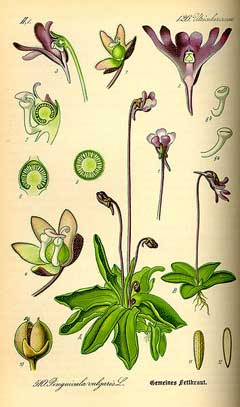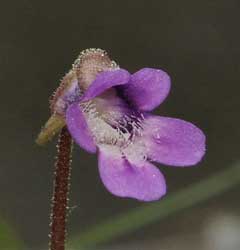 |
|
http://commons.wikimedia.org/wiki/File:Illustration_Pinguicula_vulgaris0.jpg |
 |
| http://commons.wikimedia.org/wiki/User:BerndH |
Translate this page:
Summary
Physical Characteristics

 Pinguicula vulgaris is a PERENNIAL growing to 0.1 m (0ft 4in).
Pinguicula vulgaris is a PERENNIAL growing to 0.1 m (0ft 4in).
See above for USDA hardiness. It is hardy to UK zone 3. It is in flower from May to July. The species is hermaphrodite (has both male and female organs).
Suitable for: light (sandy), medium (loamy) and heavy (clay) soils. Suitable pH: mildly acid, neutral and basic (mildly alkaline) soils. It cannot grow in the shade. It prefers wet soil.
UK Hardiness Map
US Hardiness Map
Synonyms
Plant Habitats
Bog Garden;
Edible Uses
Edible Parts:
Edible Uses: Curdling agent
The plant can be used to curdle plant milks[46, 61, 66]. The milk is poured over a strainer on which fresh leaves of butterwort have been laid. The milk is then left for a day or two until it sours when it becomes solid like yoghurt and is considered to be most delicious. A small quantity of the milk can be kept to inoculate further batches[183]. Another report says that the leaves are infused in the milk for some time[115].
References More on Edible Uses
Medicinal Uses
Plants For A Future can not take any responsibility for any adverse effects from the use of plants. Always seek advice from a professional before using a plant medicinally.
Antispasmodic Antitussive Homeopathy
Butterwort is little used in contemporary herbal medicine, though it was commonly used in the past as a purgative in Wales[254]. Its main application is as a cough remedy[254]. The leaves are antispasmodic and antitussive[7, 13]. The plant is an effective treatment for whooping cough[7]. Used externally as a poultice, it has a healing effect on the skin[7]. The leaves are harvested in early summer as the plant comes into flower and are dried for later use[7]. A homeopathic remedy is made from the plant[9]. It is used in the treatment of whooping cough and nervous throat irritations[9].
References More on Medicinal Uses
The Bookshop: Edible Plant Books
Our Latest books on Perennial Plants For Food Forests and Permaculture Gardens in paperback or digital formats.

Edible Tropical Plants
Food Forest Plants for Hotter Conditions: 250+ Plants For Tropical Food Forests & Permaculture Gardens.
More

Edible Temperate Plants
Plants for Your Food Forest: 500 Plants for Temperate Food Forests & Permaculture Gardens.
More

More Books
PFAF have eight books available in paperback and digital formats. Browse the shop for more information.
Shop Now
Other Uses
Dye
A colouring substance is obtained from the leaves[7].
Special Uses
References More on Other Uses
Cultivation details
Requires a boggy soil[1]. Because of their insectivorous habit, plants are able to succeed on soils very deficient in nitrogen. Butterwort is an insectivorous plant, the leaves are sticky and trap insects which are then digested by the plant[7]. Plants overwinter as a tight winter-resting bud with virtually no roots[200].
References Carbon Farming Information and Carbon Sequestration Information
Temperature Converter
Type a value in the Celsius field to convert the value to Fahrenheit:
Fahrenheit:
The PFAF Bookshop
Plants For A Future have a number of books available in paperback and digital form. Book titles include Edible Plants, Edible Perennials, Edible Trees,Edible Shrubs, Woodland Gardening, and Temperate Food Forest Plants. Our new book is Food Forest Plants For Hotter Conditions (Tropical and Sub-Tropical).
Shop Now
Plant Propagation
Seed - we have no information on this species but suggest sowing the seed in a greenhouse as soon as it is ripe in the summer if this is possible otherwise in early spring. Place the pots in shallow water to keep them moist. When they are large enough to handle, prick the seedlings out into individual pots and grow them on in the greenhouse for at least their first two growing seasons. Plant them out into their permanent positions in late spring or early summer, after the last expected frosts. Division of the resting buds in the winter[200]. Leaf cuttings.
Other Names
If available other names are mentioned here
Native Range
TEMPERATE ASIA: Russian Federation-Ciscaucasia (Ciscaucasia), Armenia, Russian Federation (Tyva, Respublika, Yakutia-Sakha, Irkutsk, Tyumen), Russian Federation (Kamcatskij kraj, Sakhalin), Japan (Hokkaidô, Honshu, Kyushu, Shikoku) NORTHERN AMERICA: Canada (Northwest Territories, Yukon, Québec, Ontario, Saskatchewan, Alberta (southwest), Manitoba, British Columbia), United States (Alaska, Michigan, New Hampshire, New York, Vermont, Minnesota, Wisconsin, Montana, Oregon, Washington) EUROPE: Denmark, Finland, United Kingdom, Iceland, Sweden, Austria, Belgium, Switzerland, Czech Republic, Germany, Hungary, Netherlands, Slovakia, Russian Federation (European part), Belarus, Estonia, Lithuania, Latvia, Russian Federation (Karelia, Murmansk), Ukraine, Croatia, Italy, Romania, Serbia, Slovenia, Spain, France, Portugal
Weed Potential
Right plant wrong place. We are currently updating this section.
Please note that a plant may be invasive in one area but may not in your area so it's worth checking.
Conservation Status
IUCN Red List of Threatened Plants Status :

Growth: S = slow M = medium F = fast. Soil: L = light (sandy) M = medium H = heavy (clay). pH: A = acid N = neutral B = basic (alkaline). Shade: F = full shade S = semi-shade N = no shade. Moisture: D = dry M = Moist We = wet Wa = water.
Now available:
Food Forest Plants for Mediterranean Conditions
350+ Perennial Plants For Mediterranean and Drier Food Forests and Permaculture Gardens.
[Paperback and eBook]
This is the third in Plants For A Future's series of plant guides for food forests tailored to
specific climate zones. Following volumes on temperate and tropical ecosystems, this book focuses
on species suited to Mediterranean conditions—regions with hot, dry summers and cool, wet winters,
often facing the added challenge of climate change.
Read More
Expert comment
Author
L.
Botanical References
17200
Links / References
For a list of references used on this page please go here
Readers comment
| Add a comment |
|
If you have important information about this plant that may help other users please add a comment or link below. Only comments or links that are felt to be directly relevant to a plant will be included. If you think a comment/link or information contained on this page is inaccurate or misleading we would welcome your feedback at [email protected]. If you have questions about a plant please use the Forum on this website as we do not have the resources to answer questions ourselves.
* Please note: the comments by website users are not necessarily those held by PFAF and may give misleading or inaccurate information.
To leave a comment please Register or login here All comments need to be approved so will not appear immediately.
|
Subject : Pinguicula vulgaris
|
|
|
|